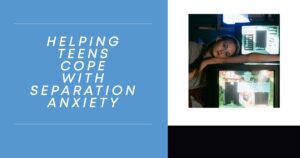Did you know that the human brain is not fully developed until about age 25, especially the part that is responsible for good decision making and impulse control? This fact about biology clarifies much of the roller coaster character of adolescence. Finding the calm before the hurricane between childlike vulnerability and fierce independence can make it hard to know where you stand on what’s normal and what may be a warning sign.
Moodiness, rebelliousness, risk-taking, and social changes are all just the adolescent experience. On the other hand, if the behaviors become intense, are seen frequently, or are disrupting a person’s normal everyday activities, it becomes an important question – could it be more serious than usual teenage stress?
In order to know where to draw the line between normal teenage behavior and abnormal behavior is imperative for parents to be able to support their teens without overreacting (or worse, missing the signs of a deeper issue). In this blog, we’ll look into what is typical during adolescence and what may be warning signs of deeper problems such as anxiety, depression, or emotional distress.
Understanding Normal Teenage Behavior Vs Abnormal
Teenage years are the years of colossal growth – physically, emotionally, and mentally. Changes in hormones and identities, and the need for independence, contribute to behavior during adolescence. Although doing so is normal among teens, testing limits or pulling away occasionally, it is a sign of something more serious if certain behaviors develop.
As a parent, you should know what is developmentally appropriate and where things may imply underlying problems. Understanding the line between normal teenage behavior vs abnormal allows you to respond with empathy while seeking support when necessary. Behaviors like mood swings, peer influence, and risk-taking are typical, but persistent anxiety, extreme rebellion, or social withdrawal might be red flags.
Navigating the Teenage Years
A short side-by-side comparison of normal developmental behaviors and signs that a closer look may be needed:
| Behavior | Normal Teen Behavior | Cause for Concern |
| Mood Swings | Occasional irritability or emotional ups and downs | Persistent sadness, anger, or emotional outbursts that disrupt daily life |
| Peer Influence | Trying new styles, slang, or habits to fit in | Sudden change in values, secrecy, or engagement in dangerous behaviors |
| Risk-Taking | Exploring boundaries, trying new experiences (e.g., driving, sports) | Repeated unsafe actions, substance abuse, or disregard for consequences |
| Independence Seeking | Wanting privacy, questioning rules, and making their own choices | Complete isolation from family, refusal to communicate, or aggressive defiance |
| Rebellion | Arguing over curfews, appearance, or friends | Destructive behavior, running away, or threats of violence |
| Anxiety | Worry about school, friends, or the future occasionally | Constant fear, panic attacks, or avoidance of daily activities |
| Social Withdrawal | Needing alone time or shifting friend groups | Loss of interest in all social interaction or hobbies, signs of depression |
| Communication | Preferring peer conversations, occasional resistance to talk | Complete shutdown, refusal to talk, or expressing hopelessness |
Hillside Horizon
Factors That Influence Teenage Behavior
Teenagers are not simply responding to the moment, they are trying to make sense of a great whirlwind of internal and external stressors. Having an acquaintance with the things that influence their behavior may give you a very useful viewpoint and let you confront obstacles with empathy and vision.

These are some of the prime forces behind a teenager’s behavior:
- Biological changes
- Emotional development
- Peer influence
- Family dynamics
- School environment
- Trauma or past experiences
- Cultural and societal expectations
The Role of Biology and Environment
Biology and the environment go together to create the way teens act, react, and develop. While biology, such as hormone shifts and brain development, provides the foundation, the programming that happens, or does not, in a child’s home life, school, and peer interactions play a major role in the outcomes of biological instigation.
Below is an account of how both biology and the environment influence teenage behavior.
| Biological Factors | Environmental Factors |
| Hormonal changes leading to mood swings or irritability | Family stress, divorce, or lack of emotional support |
| Ongoing brain development (especially impulse control) | Peer pressure and influence from social media |
| Sleep cycle shifts causing fatigue and emotional reactivity | Academic pressure and school-related stress |
| Increased need for independence and identity formation | Exposure to trauma, neglect, or inconsistent discipline |
| Heightened emotional sensitivity due to neurological wiring | Cultural norms and societal expectations affecting self-worth |
What Counts as Normal Teenage Behavior?
Teenagers do a lot of things that seem dramatic, confusing, or even worrying, however, many of these changes are a common growth experience. Being able to see what normal teenage behavior is helps avoid your overreacting to the changes that can just be a part of adolescence. Here is a table to help you see which behaviors are usually considered normal during the teen years:
| Behavior | Why It’s Normal |
| Mood swings | Hormonal changes and emotional development can cause irritability and mood shifts. |
| Desire for privacy | Teens are forming identities and need space to explore their independence. |
| Changing friend groups | Social circles shift as teens explore different values, interests, and identities. |
| Questioning authority | Pushing back on rules is part of developing critical thinking and autonomy. |
| Experimenting with appearance | Changing style, hair, or fashion helps teens express individuality. |
| Risk-taking in moderation | Trying new things like sports or debates reflects growing confidence and curiosity. |
Recognizing Abnormal Teenage Behavior
Although mood swings and independence are a natural part of adolescence, not all behavior qualifies as teenage development, and it may indicate emotional collapse, a mental health problem, or even deeper problems. Identifying abnormal teen behavior at early stages is what will help you help your child get the support they need. These could be behaviors that are normally intense, persistent, and encroach on daily life, relationships, or scholarly performance.
If your teen’s demeanor appears extreme, destructive, or further isolationist, it is of extreme importance not to brush it off as “just a phase.” If you pay attention to your instincts as a parent, when it comes to the signs, it can all make a huge difference.
Warning Signs Parents Should Watch For
The following are the signs one should watch for when differentiating between the normal and abnormal behavior of a teenager:
- Continual sadness, hopelessness, and unaided repetitive crying.
- Extreme temper outbursts or mood swings.
- Academic decline or lack of interest in school.
- Total social withdrawal or a shut-out from friends and family.
- Changes in food habits or sleeping habits.
- Dangerous or destructive behavior (such as substance use or dangerous sex).
- Exclamations of worthlessness or guilt, or low self-esteem.
- Failure to communicate or getting openly different.
- Discussions about death, dying, or suicidal thoughts.
- Physical complaints with no medical basis (i.e., stomach ache, fatigue).
Hillside Horizon
Tips for Supporting Your Teen Through Challenges
Enabling your teen begins with comprehension and holding back. Teens are still learning how to deal with big emotions, how to operate in a complex social world, and how to fill the difficult space of identity. As a parent, you can make all the difference – but it doesn’t come down to having the right answers. It’s just about showing up without judging. The following tips might help you handle your teen:
- Stay calm and available, even when they push you away.
- Validate their feelings, instead of dismissing them.
- Set healthy boundaries while still offering freedom to grow.
- Encourage healthy habits like sleep, exercise, and screen time balance.
Model emotional regulation by managing your own stress openly and positively.

The Importance of Open Communication
Trust during the teen years is based upon open communication. If your kid feels safe communicating with you, he or she will be more open to sharing an issue before it blows up. Make a space where no emotions are wrong, only worth having conversations.
Instead of trying to force them to talk, just ask questions such as “How is your day going?” or “Is there anything you need from me today?” Don’t be a consistent listener, but rather a fixer.
Get Help at Hillside Horizon for Teens Today
Whether your teen’s behavior is typical or something scarier, you’re not alone, but you don’t have to be on your own. At Hillside Horizon for Teens, we are experts in supporting adolescents, teenagers, and their families in developing emotional and behavioral difficulties compassionately and competently.
One way or another, whether your child is demonstrating signs of anxiety, rebellion, or social withdrawal, our licensed professionals are on hand to assist your family with customized counseling and intervention programs that will work.
Hillside Horizon
FAQs
What are the signs of normal teenage mood swings versus extreme changes indicating abnormal behavior?
Healthy teenage mood swings are also brief ones caused by certain events, such as school stress or social drama. Extreme, or prolonged changes in mood, for weeks or more, and those that affect everyday life and relationships may point to a deeper emotional or mental health problem.
How does peer influence impact risk-taking behaviors in teenagers, and when should parents be concerned?
Peer influence can lead to trying trends, behaviors, or identities that are usually harmless and temporary. But an alarm is triggered when teens perform reckless deeds such as substance use, careless driving, involvement in illegal activities to be in with the in-group, or get approval.
At what point does social withdrawal in teenagers become a sign of potential mental health issues like persistent sadness or anxiety?
It’s normal for teens to want some time alone, but withdrawal from friends and activities, cutting out family contact altogether, and /or sitting in a room in the dark for hours can be signs of depression or anxiety. If they appear to be uninterested, emotionally numb, or becoming further isolated, it’s time to get help.
How can parents differentiate between independence and self-discovery in teens and excessive aggression or rebellion?
Perfect independence encompasses polite boundary testing, decision-making, and adventuring on the identity front. Aggression or violent behavior, as well as complete denial to respect any rules, can indicate some other, deeper emotional problems that should be addressed.
When should parents worry about abnormal teenage behaviors like persistent sadness or extreme anxiety in their children?
When feeling sad, anxious, or stressed, if your teen’s lack of sleep, school performance, relationships, or self-worth are being impacted, none of these things should be ignored. Long-term emotional agony is often an indication of a condition of the mind that can use early help from an expert.





